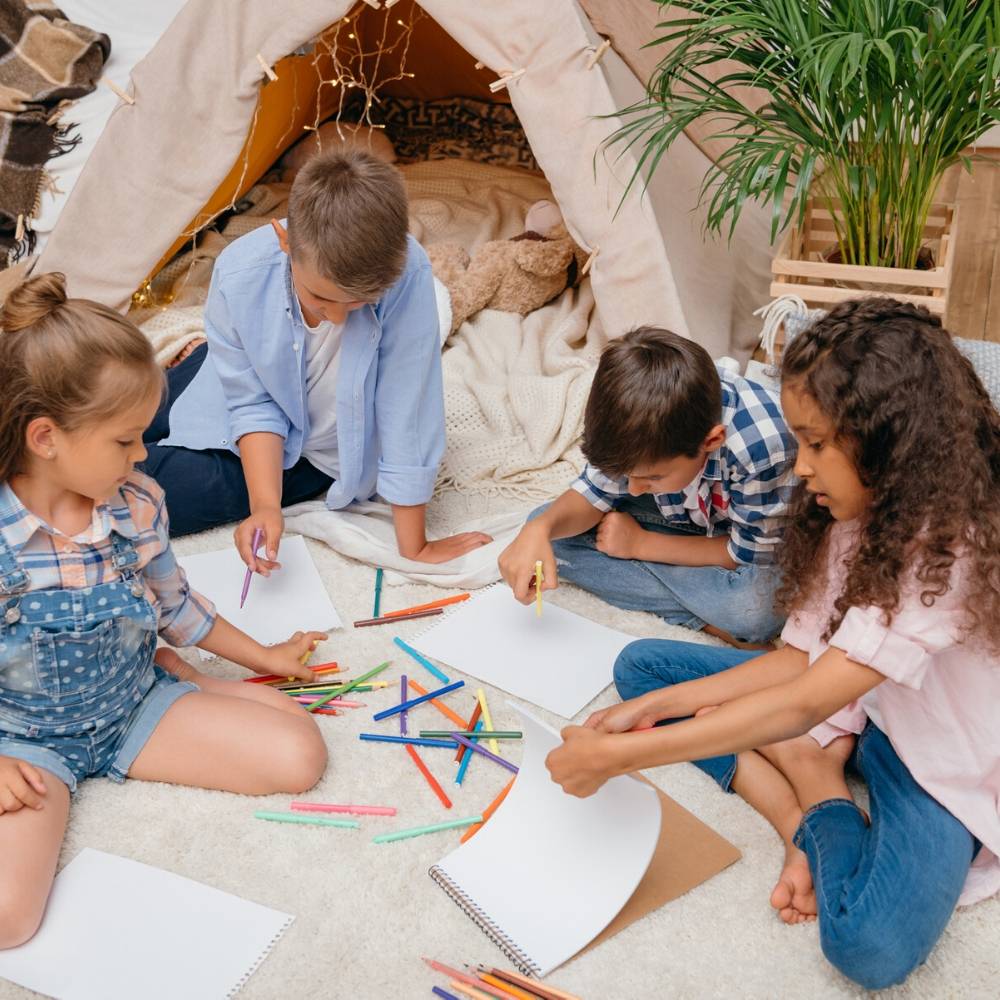Table of Contents
When the rain is pouring outside, you can always bring the fun indoors! Don’t let the weather dampen your spirits or your kids’ enthusiasm. So, we at Omega Pediatrics have compiled a list of fun indoor activities to keep your little ones entertained and engaged despite the gloomy weather.
The activities are designed to spark their imaginations, boost their creativity, and provide educational experiences. So, gather your supplies, put on your thinking caps, and get ready to have a blast with these fun-filled indoor adventures!
Rainy Days can be a Challenge for Parents with Energetic Kids
When it rains outside, kids are stuck inside and may become bored or restless. They have a lot of pent-up energy that they can’t release outside, leading to frustration and tantrums. Parents feel overwhelmed trying to keep their kids entertained and occupied for an extended period of time.

22 Rainy Day Games and Activities for Energetic Kids
Rainy days can be a challenge for families looking to keep kids entertained and engaged. But with a bit of creativity, these indoor activities can turn a dreary day into a fun-filled adventure. Here are 10 activities that will keep your kids busy, happy, and learning.
1. Build a fort using blankets and pillows
Transform your living room into an imaginative fortress. Drape blankets over furniture and use pillows as walls. Create cozy spaces for reading or storytelling. Let children decorate their fort with drawings or hang fairy lights for added ambiance.
2. Create an indoor treasure hunt with clues
Write clues on paper leading kids from one location to another, ultimately leading to a hidden treasure. Use their problem-solving skills and make it educational by incorporating trivia questions related to history, science, or geography. Reward them with small prizes or treats when they find each clue.
3. Set up an indoor obstacle course
Use cushions, hula hoops, and other household items to create a fun obstacle course. Children can crawl under tables, jump over pillows, and navigate their way through the course. Time them to challenge their speed, or let them complete it without touching the ground for an added twist.
4. Have storytime
You can’t go wrong with a good old-fashioned storytime. If your kids are old enough, they can take turns reading. This not only fosters a love for books but also improves their reading skills.
5. Sort through old toys
Your playroom will be much more organized, and you and your kids may discover some old toys you can store or donate. This activity can also teach children about decluttering and the joy of giving.
6. Go to the library
When you want to get everyone out of the house for free, the local library can’t be beaten. Libraries often have books, audiobooks, DVDs, and fun kits to check out. Many also offer a full programming schedule for kids, including storytime and craft sessions.
7. Bake cookies
Tie on your aprons and let little ones help mix, roll out dough, and decorate—and then enjoy! Baking is not only fun but also a great way to teach kids about measurements and following instructions.
8. Make pizza
While cookies are nice and easy for younger children, more advanced baking or cooking projects can be fun for elementary- or middle-school-aged kids. Pizza is fun, as it’s easy to roll out the dough, spread on the sauce, and layer on the toppings. Plus, it’s a delicious way to spend time together.
9. Play a board game
The classics are great, but there are also tons of newer board games perfect for kids. Favorites include Blank Slate, UNO Attack!, and Clue Junior. Board games can enhance critical thinking, strategy skills, and family bonding.
10. Try mindfulness exercises
Have kids reflect on how their week is going. This can be very beneficial for kids to help promote time management skills and set a daily schedule. Mindfulness exercises can also help them manage stress and improve focus.
11. Create a puppet show and put on a performance
Craft puppets using socks or paper bags. Develop a storyline and encourage children to act out scenes, promoting creativity and communication. Help them construct a simple puppet theater using a box or cardboard. Invite friends or family to watch the performance and applaud their efforts.
12. Have an indoor picnic with a blanket and picnic food
Spread a blanket on the floor, prepare sandwiches and snacks, and enjoy an indoor picnic. Discuss nature, talk about favorite foods, and enjoy quality family time. You can also play “I Spy” with objects in the room or share interesting facts about the environment to make the picnic educational and interactive.
13. Have a dance party with your child’s favorite songs
Clear a space and play energetic music. Encourage kids to dance, imitate their favorite performers, and invent their moves. Teach them different dance styles or challenge them to create a dance routine together, promoting self-expression and physical fitness.
14. Put on a fashion show with dress-up clothes
Let children raid the dress-up box or their closets to create unique outfits. They can model their creations and explain their fashion choices. Discuss the history of fashion or different cultural clothing traditions to foster cultural appreciation and creativity.
15. Create a miniature indoor golf course with household items
Use cardboard tubes, plastic cups, and other objects to set up a mini-golf course. Children can practice their hand-eye coordination and learn about physics by experimenting with different angles and forces. Challenge them to design their golf holes for added creativity.
16. Make paper airplanes and have a flying contest
Teach children how to fold paper airplanes and challenge them to see whose plane flies the farthest or the longest. Explore aerodynamics and physics concepts by adjusting designs and discussing the principles of lift, drag, and thrust. Experiment with different paper types or modifications for added fun.
17. Set up a mini indoor bowling alley
Arrange empty plastic bottles or paper cups as bowling pins. Use a soft ball and take turns bowling, improving coordination and counting skills. Create scorecards and discuss basic math concepts like addition and subtraction as you keep scoring.
18. Have a family movie day
Pop some popcorn, pull out the blankets, and settle in to watch a new movie or an old favorite. This is a cozy way to spend the day and can become a family tradition.
19. Play Globle
This is an online geography-based guessing game that allows kids to practice and grow their geographic knowledge on a global scale. The object is to figure out which country is the mystery country by guessing the names of other countries that are close to it. You can play it once a day or use the practice mode function to play as many times as you want.
20. Have a living room dance party
This is a great way to get the wiggles out. Everyone in your family can take turns putting on their favorite songs and dancing.
21. Solve some riddles
Riddles are a great way to pass the time and get kids to think outside of the box. His favorite ones force kids to call on their math skills.
22. Play school
As a fun twist, let your kid be the teacher, and you be the student. This role reversal can be empowering for kids and provide insight into their learning styles.
By mixing and matching these activities, rainy days can become an opportunity for fun, learning, and family bonding.

10 Fun and Educational Activities for Kids to Do on a Rainy Day
1. Bake cookies or a cake together.
Teach kids the basics of baking. Let them measure the ingredients, mix the batter, and decorate the finished product. Explain the science behind baking, discussing how ingredients interact and change during the process. Encourage creativity by allowing them to experiment with different flavors or decorations.
Enjoy Together: After all the hard work, sit down as a family to enjoy the delicious treats you’ve made together. This not only rewards the effort but also creates lasting memories.
Interactive Fun: Tie on your aprons and let little ones help mix, roll out dough, and decorate cookies. This hands-on approach makes the activity engaging for kids of all ages.
2. Play board games or card games.
Engage in classic board games or card games, which can enhance critical thinking, strategy, and social skills. Choose age-appropriate games for the best experience. Introduce new games from different cultures or periods to broaden their understanding of different play styles and traditions.
3. Put together a jigsaw puzzle.
Select a puzzle suitable for your child’s age and difficulty level. Work together to solve it, improving spatial reasoning, problem-solving, and patience. Discuss the image on the puzzle, whether it’s a famous painting, a world map, or an animal scene, to encourage curiosity and learning.
4. Create and play with homemade slime.
Combine ingredients like glue and borax to create slime. Kids can explore the science behind it and have fun playing with the squishy substance. Experiment with different colors, textures, or add-ins like glitter or small toys to make unique slime creations.
5. Set up a DIY science experiment.
Conduct simple experiments using everyday materials. Examples include making a volcano erupt with baking soda and vinegar or growing crystals with salt and water. Explain the scientific concepts behind the experiments and encourage children to ask questions and make predictions about the outcomes.
6. Teach and learn magic tricks.
Teach children simple magic tricks using everyday objects. They can practice their performance skills and learn the art of illusion. Discuss the science and psychology behind each trick, helping them understand how perception and misdirection work to create magic.

7. Have a storytelling session using imagination and props.
Encourage children to create their own stories using their imagination and props. This activity boosts creativity, language skills, and narrative abilities. Provide a variety of props, like hats, toys, or random objects, to inspire their storytelling and make it more engaging.
8. Solve puzzles and brain teasers.
Offer age-appropriate puzzles, riddles, or brain teasers. Engaging with these challenges develops problem-solving skills and critical thinking. Encourage children to work together or compete in solving puzzles, promoting teamwork and friendly competition.
9. Learn and play a musical instrument.
Introduce kids to basic musical instruments like keyboards, recorders, or xylophones. Teach them simple melodies and encourage their creativity. Discuss different music genres or composers, allowing them to explore and appreciate a wide range of musical styles.
10. Design and build a mini robot or an engineering project.
Utilize household items and recyclables to construct a simple robot or engineering project. Encourage problem-solving, engineering skills, and creativity. Discuss the basic principles of robotics or engineering concepts as they design and build their creations. Encourage them to troubleshoot and iterate on their designs for better functionality.
6 Quiet Activities for Rainy Days
1. Have a family movie marathon.
Choose a theme or series of movies and create a cozy movie-watching experience with popcorn and blankets. Discuss the movies afterward, encouraging critical thinking and storytelling skills. Have children share their favorite scenes or predict what might happen next in the story.
2. Build structures with LEGO or building blocks.
Encourage creativity and engineering skills by constructing various structures using LEGO or building blocks. Challenge kids to build tall towers or recreate famous landmarks. Introduce architectural concepts like stability, balance, and symmetry to spark their interest in design and construction.
3. Make a scrapbook or photo album.
Collect photographs, cutouts, and other mementos. Arrange them in a scrapbook or photo album to preserve memories and foster storytelling abilities. Encourage children to write captions or stories alongside the photos, reflecting on their experiences and the emotions captured in each image.
4. Do yoga or exercise together.
Follow kid-friendly yoga videos or engage in simple exercises together. Teach children the importance of physical activity and mindfulness. Explain the benefits of each pose or exercise, such as flexibility or strength, and encourage them to explore their bodies’ capabilities.
5. Paint or draw pictures using various art supplies.
Provide paper, paints, markers, or colored pencils. Encourage children to express their creativity through art and discuss their creations. Introduce different art techniques or famous artists to inspire their work and expand their knowledge of artistic styles.
6. Make homemade playdough and sculpt shapes.
Create playdough using flour, salt, and water. Children can mold and shape it into different objects, enhancing their fine motor skills and imagination. Encourage them to experiment with textures, colors, and scents by adding natural ingredients like food coloring, essential oils, or spices.

Make Rainy Days At Home Fun
Rainy days don’t have to be dreary and boring. With fun indoor activities for kids on rainy days, you can turn a gloomy day into a day filled with excitement, creativity, and learning! So, the next time raindrops fall outside, don’t let them dampen your spirits. Instead, embrace the chance to have a blast indoors!
We at Omega Pediatrics want you and your kids to have fun, no matter how the weather is outside. Just a reminder, though: if your kids ever get wet because of the sudden rain, let them take a shower first to remove all the dirt and avoid getting sick.
FAQ
Why are rainy days challenging for parents with energetic kids?
Rainy weather often keeps kids indoors, leading to boredom and frustration due to pent-up energy.
What are some indoor activities to keep kids entertained on rainy days?
Building forts, treasure hunts, obstacle courses, puppet shows, and indoor picnics are great options.
How can parents make rainy days educational for their kids?
Engage in baking, board games, puzzles, DIY science experiments, storytelling, and musical instrument learning.
What are some quiet activities suitable for rainy days?
Family movie marathons, LEGO building, scrapbooking, yoga, art sessions, and homemade playdough sculpting.
How can parents ensure their kids have fun on rainy days while staying healthy?
Encourage hygiene by having kids take a shower if they get wet, especially after playing in the rain.
How Can Dancing with Umbrellas Be a Fun Rainy Day Activity for Kids?
Rainy days don’t have to mean staying cooped up indoors. One delightful way to make the most of the weather is by dancing with umbrellas. Here’s why it can be such an enjoyable activity for kids:
1. Encourages Physical Activity
Dancing is an excellent way for kids to burn off energy. Adding an umbrella into the mix adds an element of playfulness, making it even more engaging. Children can twirl, jump, and spin, all while staying active.
2. Sparks Creativity and Imagination
Imagine the joy of becoming a part of a whimsical story where umbrellas are magical props. Kids can create their own dance routines and scenarios, transforming the mundane into a vibrant adventure. This imaginative play fosters creativity and cognitive development.
3. Enhances Coordination and Balance
Holding an umbrella while dancing requires a bit more coordination and balance than usual. This can help improve their motor skills without them even realizing it. Plus, navigating wet surfaces adds an extra layer of fun and challenge.
4. Provides a Unique Sensory Experience
Rainy days offer unique sensory experiences—like the sound of raindrops tapping on an umbrella, the cool splash of puddles underfoot, and the fresh scent of rain. Dancing with umbrellas allows kids to fully immerse themselves in these experiences, making the activity both fun and educational.
5. Promotes Teamwork and Social Interaction
If more than one child is involved, dancing with umbrellas can turn into a group activity that encourages teamwork. Kids can choreograph group dances or simply enjoy the company of their friends, learning the importance of cooperation and social interaction in the process.
6. Safe and Simple
Umbrellas are a safe prop for children to use during play. They are lightweight, easy to handle, and can be an exciting addition to many types of dance. Just make sure to supervise young kids to prevent any accidental bumps or pokes.
Tips for Making Umbrella Dancing Even More Fun
Play Music: Choose lively tunes that inspire movement.
Dress Up: Raincoats and colorful boots can add to the excitement.
Puddle Jumping Combos: Combine dancing with puddle jumping for extra thrills.
Theme Dance: Create thematic dances, like pretending to be in a musical or fairy tale.
Conclusion
Next time the rain starts pouring, grab some umbrellas and head outside for a dance. It’s a simple, fun, and enriching activity that transforms a gloomy day into a memorable experience for kids.



